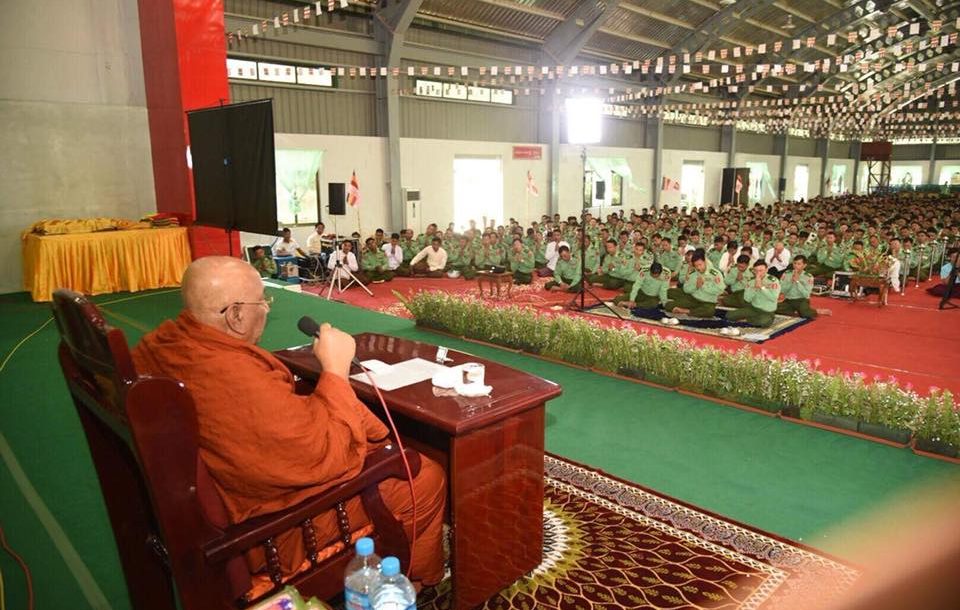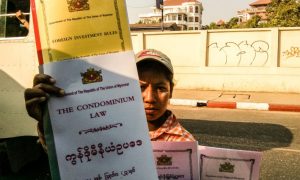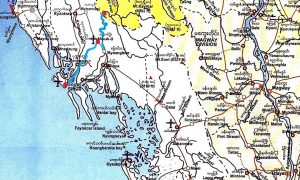Sitagu Sayadaw is one of the most respected religious leaders in Myanmar. He is very well known for his teachings and for his philanthropic work. He has considerable influence. It therefore surprised many in his native Myanmar and worldwide when he gave a sermon in Kayin State on 30 October with a particularly striking message. The sermon appeared to suggest that the killing of those who are not Buddhist could be justified on the grounds that they were not complete humans, or indeed humans at all.
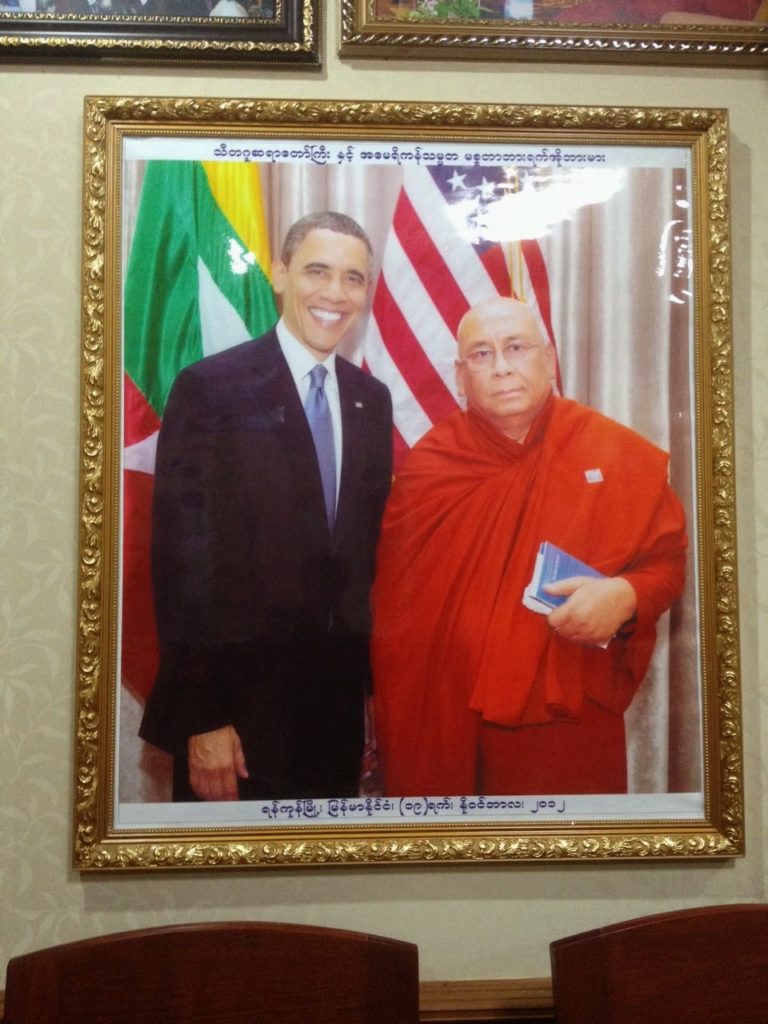
A photo of Sitagu Sayadaw with Barack Obama in 2012 (via Burma Dhamma blog)
There has been much online discussion about the passage. In its extreme form, there is the idea that Sitagu Sayadaw argued that non-Buddhists are less than human, and that on this basis it is permissible to cause them harm. How could such a revered teacher as Sitagu Sayadaw preach such a message? Particularly troubling was that the sermon was given to a group of army officers likely to be involved in the conflict against Muslim Rohingyas. The interpretation could be that this was a Buddhist justification for the killing of Rohingyas.
The sermon was indeed delivered to army officers at the Bayintnaung garrison and military training school in Kayin State. In reflecting on the relationship between the actions of the Burmese military and the consequences of a soldier’s duty to protect the Myanmar nation, Sitagu Sayadaw used the 5th Century CE Sri Lankan chronicle, the Mahavamsa. He also chose to quote from a notorious passage from the 25th chapter of the Mahavamsa, “The Victory of Dutthagamani”. The passage in question appears to go against many of what most people would understand to be the key ideas of Buddhism. One possible way to interpret it is simply to suggest that “Buddhists are as capable of hypocrisy, double standards and special pleading as anyone.”
I would suggest that the primary intention of the Dutthagamani passage is not to justify the killing of living beings who are not Buddhist per se. The point of the passage—however much we might disagree with its logic—is the idea that actions performed with the idea of protecting and defending Buddhism, or “bringing glory to the doctrine of the Buddha”, overrides more accepted ethical norms such as the precept of not killing living beings. Protecting the Dhamma circumvents the usual operation of karma. All actions have consequences, but the effects of these actions can be lessened if the motivation for them is a noble one.
In case I am misunderstood, I would like to state clearly that the use of the passage was unwise in the extreme by the revered Sayadaw. It is also a passage which sits very uneasily with mainstream Buddhist thinking on the use of violence. However, it can, has, and is being used by Buddhists to describe how “unwholesome actions” (Burmese: arkhutho Pali: akusala-kamma) can be used to defend and preserve Buddhism.
In the famous episode recounted in the Mahavamsa, Dutthagamani, having waged a long and bloody war in which millions were killed, suffers from extreme unease and remorse. Through their supernatural powers, a group of eight Arahants become aware of this remorse and travel to see Dutthagamani. Using their supernatural powers, they travel through the air from the Island of Piyangudipa to comfort him. However, Dutthagamani tells the Arahants:
How shall there be any comfort for me, O venerable sirs, since by me was caused the slaughter of a great host numbering millions?
He is then famously advised:
From this deed arises no hindrance in thy way to heaven. Only one and a half human beings have been slain here by thee, O lord of men. The one had come unto the (three) refuges, the other had taken on himself the five precepts. Unbelievers [they have “wrong-views”, micchādiṭṭhi] and men of evil life were the rest, not more to be esteemed than beasts. But as for thee, thou wilt bring glory to the doctrine of the Buddha in manifold ways; therefore cast away care from thy heart, O ruler of men!
In the sermon or the original text as they stand there is no mention of “Buddhists” and “non-Buddhists”. Equivalent terms are not available in Pali or in Burmese. But much of the news reporting of Sitagu Sayadaw’s sermon has contained a degree of hyperbole, suggesting that this was its message. What the passage does appear to do, however, is absolve the consequences of the military killing other living beings, and even to justify these acts. This is the manner in which it was quoted by Sitagu Sayadaw.
The episode is an analysis of Dutthagamani’s remorse. He has remorse because he is responsible the deaths of millions of people. He considers that he has performed very destructive “unwholesome actions” (Burmese: arkhutho. Pali: akusala-kamma). The comforting words of the Arahants explain why these actions do not have the consequences that we might expect. The Arahants’ analysis is based upon the idea that the “deeds”, the “actions” (kamma), the killing of millions of “human beings” (manussa) have no negative consequences because of the status of those killed. The Arahants, through their “higher knowledge” (abhiññā) make a judgement on the ontological and spiritual nature of those defeated in the battle. Dutthagamani’s victims are “unbelievers” in Wilhelm Geiger’s translation; more correctly, they have “wrong-views” (micchādiṭṭhi). They are “men of evil life” (dussilā), they do not practice ethical conduct. They are, in the logic of the Mahavamsa not “human beings” but “like beasts” (pasusamā).
How, then, does the Mahavamsa describe a “human being”? A full human is one who has taken refuge: in the Buddha, the Dhamma, and the Sangha. Secondly, to be human in the context of the Arahants’ explanation is to have practiced the “five precepts” (pañcasīla). These are the five ethical practices of a layperson: to refrain from killing, lying, stealing, sexual misconduct, or intoxicants that cause confusion. Therefore, those who do not practice the five precepts are “half of a person” in the advice of the Arahants.
It would clearly be wrong to assume that this is a general appraisal of the nature of a person in Buddhism. The Arahants have the specific task of consoling Dutthagamani. To use this as a justification for violence would surely be to misuse the text.
Nevertheless, one apparent implication of the Arahants’ reasoning is that the glory brought to the religion of the Buddha overrides other more natural ideas of what is right and wrong. Dutthagamani brings “glory to the doctrine of the Buddha” (bahudhā buddhasāsana). This is a theme found earlier in this chapter of the Mahavamsa in which a vitriolic blend of preserving Buddhism, and using violence in its defence, is clear: “not for the joy of sovereignty is this toil of mine, my striving (has been) ever to establish the doctrine of the Sambuddha”.
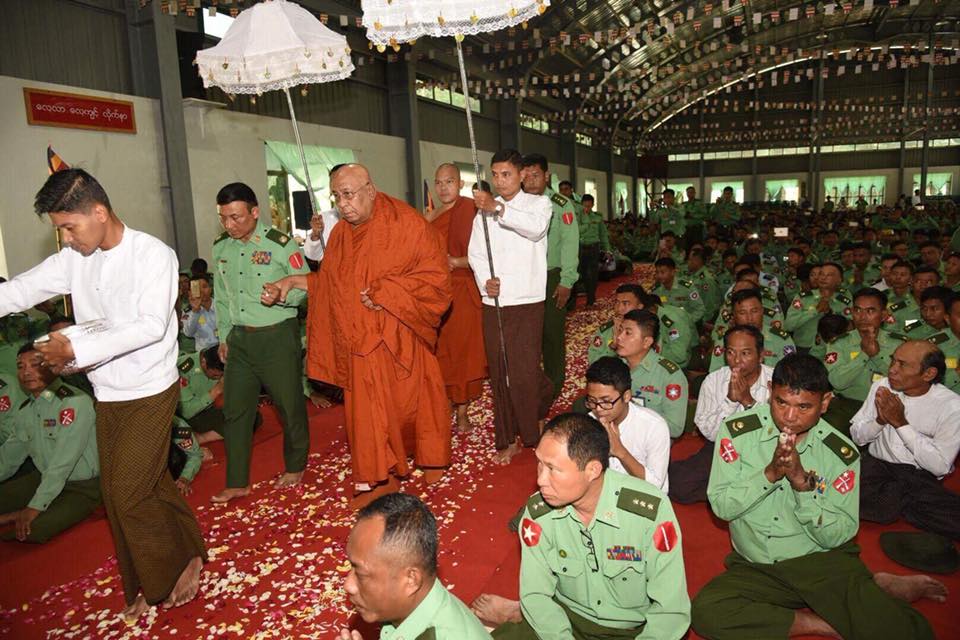
Sitagu Sayadaw arriving at the site of his sermon to military officers on 30 October (Photo: @sayadawsitagu on Facebook)
What was Sitagu Sayadaw doing in using this infamous passage? (Interestingly, in the sermon he appears to be aware of the sensitivity of the message he is preaching. He repeatedly suggests that it is not he who is teaching in this way: as he notes, “the Arahants said it”). The protection of Buddhism, of the sāsana, is key in the recent Burmese discourse about the relationship of Buddhism and national identity. The protection of Buddhism is both a rallying call of Burmese Buddhist nationalists, and a key element in what it means to be Burmese.
At stake in many of the countries in which a chauvinistic form of Buddhism is gaining followers is the question of Buddhist and national identity. In Myanmar this identity is being polarised around ideas of “nation, language and religion” (amyo-barthar-tharthanar). There is the idea that Buddhism is under threat and needs to be protected. The threat is usually thought to be from a growing Muslim population. The Mahavamsa passage can be used to suggest the idea that Buddhism stands in opposition to other religious traditions. The four recent “race and religion protection laws”, promoted by MaBaTha (“the organisation for the protection of race and religion”) emphasise similar notions.
It might then not come as a surprise that Sitagu Sayadaw used the Mahavamsa and the story of Dutthagamani in the way that he did. Much of the outrage caused by its use is justified. Its message contradicts many of the fundamental principles of Buddhism. This is not to dismiss what the Mahavamsa is arguing. The text has a point: that at times, defending the tradition overrides ethical concerns. Usually, however, the focus of Buddhist teachings is concerned with achieving liberation. The Buddhist path begins with undertaking ethical actions and in promoting wholesome actions of body, speech and mind.
But the fact is that one of the most renowned Buddhist monks in Myanmar has used the Mahavamsa to justify violence. Its use might provoke the Burmese Buddhist community to reflect upon how distant this nationalistic Buddhism of modern Myanmar is from the cherished ideals of that more familiar Burmese Buddhism based upon compassion and kindness. Additionally, Sitagu Sayadaw’s sermon might encourage us to question our commonly held ideas about the nature of Buddhism in Myanmar. Given his reputation, we might have expected that the Sayadaw would have renounced all forms of violence against the Rohingya. The fact that he does the opposite alerts us to a more intolerant form of Buddhism becoming popular within Myanmar.
 Facebook
Facebook  Twitter
Twitter  Soundcloud
Soundcloud  Youtube
Youtube  Rss
Rss 